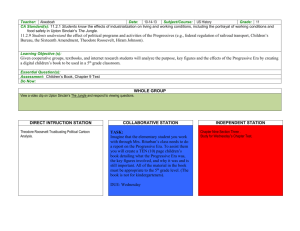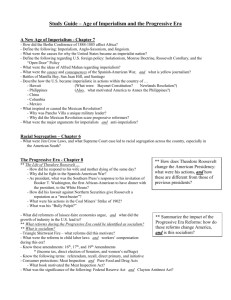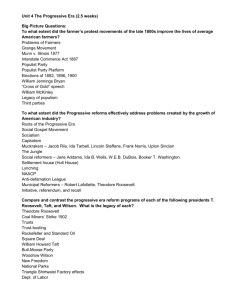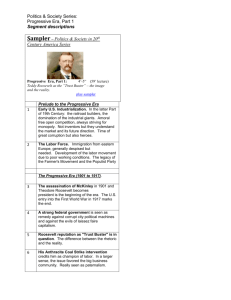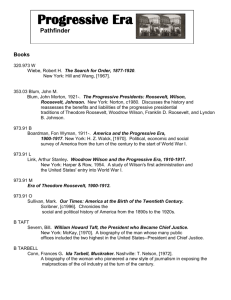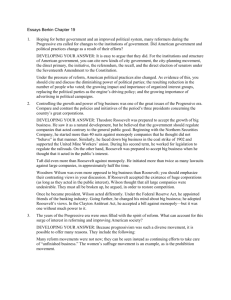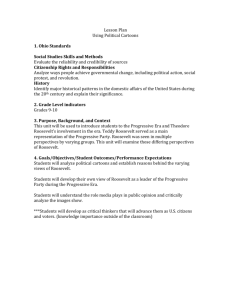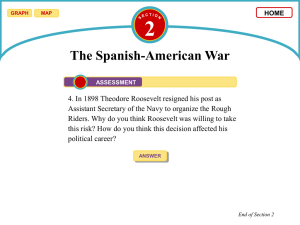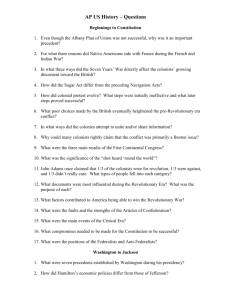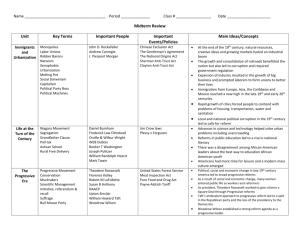Chapter 6 A New Industrial Age
advertisement
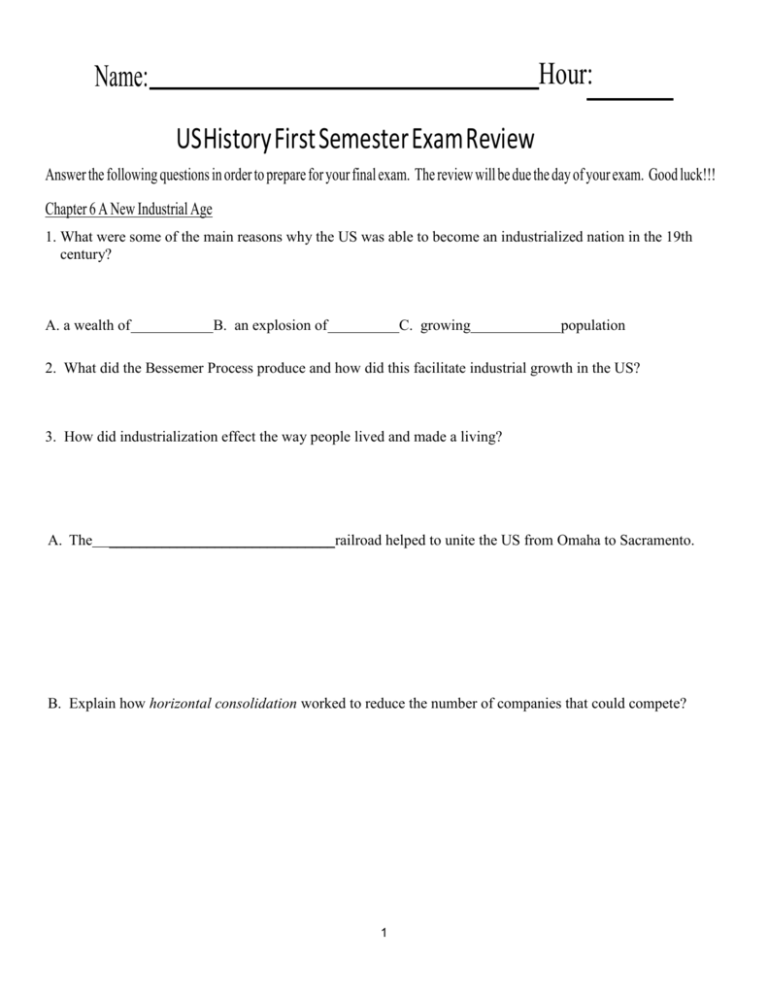
Hour: Name: US History First Semester Exam Review Answer the following questions in order to prepare for your final exam. The review will be due the day of your exam. Good luck!!! Chapter 6 A New Industrial Age 1. What were some of the main reasons why the US was able to become an industrialized nation in the 19th century? A. a wealth of B. an explosion of C. growing population 2. What did the Bessemer Process produce and how did this facilitate industrial growth in the US? 3. How did industrialization effect the way people lived and made a living? A. The ______________________________railroad helped to unite the US from Omaha to Sacramento. B. Explain how horizontal consolidation worked to reduce the number of companies that could compete? 1 4. How did Andrew Carnegie use a process known as vertical integration to dominate the steel industry? 5. are buildings reaching in excess of 3 stories and were made possible in the 19th century through the development of steel. 6. True or False. ------ Industrial trusts and monopolies increased the amount of competition between businesses in the US. 7. were formed by workers in many industries because they felt they would have more bargaining power with management through collective bargaining rather than individual negotiations. Chapter 9 The Progressive Era 8. Summarize the main ideas of the following amendments to the US Constitution from the Progressive Era: 16th: 17th: 18th: 19th: 9. What were the primary goals of the Progressive Era? 10. The place in the was written by Upton Sinclair and exposed some of the most major abuses taking industry. 11. Who were the three Progressive Era presidents? 12. President Theodore Roosevelt promised Americans a a. What was the Meat Inspection Act? b. What was the Pure Food and Drug Act? c. Why was President Theodore Roosevelt called the “Trust Buster”? 2 Deal. 13. President Taft became a after his time in the White House and eventually gave the oath of office to President Coolidge in 1924. 14. Which Progressive Era president created the Federal Reserve System which drastically changed the way the American banking system operates? 15. Who were the people the President Roosevelt referred to as the muckrakers and why did he give them this name? 3 Chapter 10 US Imperialism 16. is when stronger nations impose themselves economically, militarily, and culturally onto other nations. (i.e. US involvement with the Philippines, Cuba, China in the later 19th and early 20th century) 17. What specific things led to Imperialism? (There are 3 causes) 18. In Alfred T. Mahon’s book The Influence of Sea Power Upon History, the author maintained that the US would need a controlling naval presence in which parts of the world? 19. How did the DeLome Letter and the sinking of the USS Maine eventually get the US into a war with Spain in 1898? A. What were the specific agreements in the Treaty of Paris which officially ended the Spanish-American War of 1898? 4 20. What was the Roosevelt Corollary and how was it an extension of the Monroe Doctrine? 21. Admiral became a US war hero when he sailed into Spanish Navy at the outset of the Spanish-American War. 22. and defeated the was the last queen of Hawaii before the island nation was annexed by the US. 23. US Secretary of State John issued the Door Notes to the world’s other imperialist nations declaring the US had the right to trade with China. 24. What type of geographical feature was the Panama Canal built across? Chapter 11 The First World War 25. Write down the nations that were members of the Central and Allied Powers during WWI. Central Powers Allied Powers 26. What were the four long-term causes of World War I. (Remember: M.A.I.N.) 5 27. How did the US initially feel about World War I and why did this sentiment eventually change by 1917? a. What were the primary reasons why the US eventually entered WWI? 28. President Wilson’s famous speech to Congress on January 18, 1918 which conveyed his plans for world peace was known as the speech. 29. What were the major weaknesses of the Treaty of Versailles which officially brought an end to World War I? Chapter 12-13 The Roaring 20’s 30. was a 1920’s artistic movement that promoted the talents and influence of African American culture in the United States. A. What was President Harding’s 1920 campaign promise? “A Return to 31. Who was the “Ohio Gang” and what was the Teapot Dome Scandal? 6 ” 32. The Trial was a famous court case regarding the teaching of evolution in public schools and served to represent the tensions that existed between and communities. 33. What was the Great Migration which began during World War I and last through World War II? Chapter 14 The Great Depression Begins 34. What was the Great Depression and what were some of its primary causes? a. What was a shantytown and why did people call them Hoovervilles? 35. What were the primary causes of the collapse of the stock market in 1929? 36. In the spring of 1932 a group of World War I veterans known as the Washington DC demanding an early pay out on their pension. Ultimately, General the veterans out of the city which cost President the election of 1932. 37. Define Dust Bowl? 7 marched into drove Chapter 15 The New Deal 38. What was the name of President Franklin Roosevelt’s plan to get the US out of the Great Depression? a. What were the 3 R’s that President Roosevelt’s program addressed? b. What was the most remembered line from President Roosevelt’s inaugural address? What did he mean by this statement? 39. What was the President’s first action regarding the banks upon becoming President in 1933? 40. Define: Brain Trust 41. Why have so many historians referred to the New Deal as Alphabet Soup? 42. Fireside Chats were speeches given by President Roosevelt and heard by millions of Americans on the . 8 43. What were some of the programs created by the New Deal that sought to put people back to work in one way or another? (page 500) CCC FERA PWA WPA NYA FDIC NRA SEC FDC AAA TVA FHA National Labor Board (Wagner Act) Social Security Administration 44. How was the government able to pay for the costs of the New Deal when the economy as a whole was doing so poorly? 45. Why did FDR want to add members to the Supreme Court which became known as “Court Packing”? 46. Why did the FDR want to reduce the supply of agricultural goods through the Agricultural Adjustment Act (AAA)? 9 Important Key Terms to know: 1. Amendments: 18th and 21st 15. Meat Inspection Act 2. Bessemer Process 16. Muckrakers 3. Brain Trust 17. National Debt 4. Causes of urban sprawl 18. Progressive Era 5. Direct Relief 19. Pure Food and Drug Act 6. Dust Bowl 20. Reasons people migrated to cities in the 1900s 7. Federal Emergency Relief Administration 21. Samuel Gompers and the American Federation of Labor 8. Glass-Steagall Act 22. Settlement houses 9. Goals of the “New Deal” 23. The Teapot Dome scandal 10. Harlem Renaissance 24. US annexation of Hawaii (the influence of missionaries) 11. Imperialism 12. Interstate Commerce Act 25. Why was it difficult to enforce prohibition? 13. John T. Scopes 26. Wilson’s Fourteen Points 14. Main objective of the Agricultural Adjustment Act 27. Yellow journalism 10
